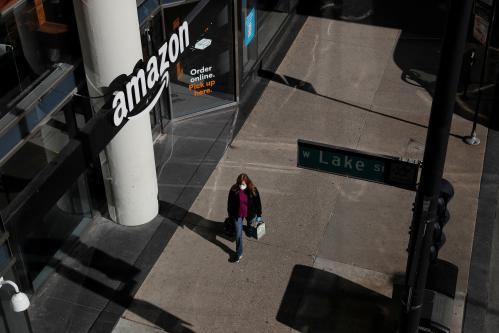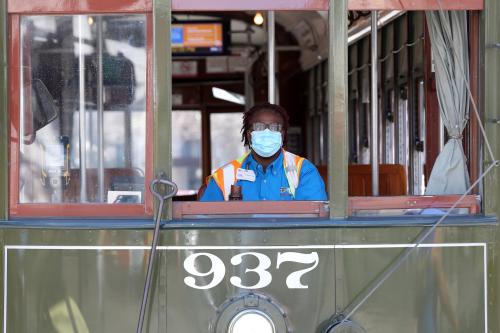Amid rising layoffs and rampant uncertainty during the COVID-19 pandemic, it’s a good thing that Democrats in the House of Representatives say they plan to move quickly to advance the next big coronavirus relief package. Especially important is the fact that Speaker Nancy Pelosi (D-Calif.) seems determined to build the next package around a generous infusion of aid to hard-hit state and local governments.
Five weeks ago, my colleagues Timothy J. Bartik, Brad Hershbein, Bryan A. Stuart, and I made the case for early and substantial aid to these governments, and in recent weeks, so have Brookings’s Matthew Fiedler and Amy Liu, the Economic Policy Institute, the Center on Budget and Policy Priorities, Vox’s Dylan Matthews, and many others.
All of us argue that while the most heart-rending costs of the recession are the human ones, some of the most insidious pain will emanate from a coming crisis within state and local governments: collapsing revenues, increased demand for safety net programs like Medicaid, and the direct costs of leading the COVID-19 response. In that vein, all of us estimate that states and localities will face revenue shortfalls in the hundreds of billions of dollars by the end of 2021, which will force them to make deep cuts in public services.
For that reason, Democrats’ determination to advance another big, expensive relief package focused on state and local aid is critical. Only massive federal aid to states and localities—to the tune of $700 billion to $1 trillion over the next 18 months—will be sufficient to blunt the coming service cuts and layoffs as well as keep regional fiscal contractions from deepening the crisis and slowing the recovery.
But there is still more to consider here. Without excessively overcomplicating the bill’s design, it is imperative that any aid package be crafted to respond to the likely large variations among states’ economic conditions as the recession deepens. The simple fact is that the pain of recessions does not hit all areas equally.
Already, state-by-state unemployment claims data show significant variation not just in aggregate new caseloads but in the claims’ shares of a state’s overall workforce. These shares vary from 5.1% in South Dakota to 22.5% in Hawaii. That gulf by itself implies sizable variations in states’ budget gaps, given the historical relationship between unemployment rates and state tax revenue.

Looking out a bit further, rough Brookings Metro depictions of the geography of industries and occupations vulnerable to COVID-19-related layoffs reinforce that the deepening recession is not going to damage all local economies equally. Instead, it will most affect economies tied intensively to tourism, travel, discretionary retail, and energy—think Florida, Louisiana, Nevada, and Hawaii—more than others.

The above map shows that some states are contending with the reality that whole swaths of their landmasses that remain depressed from the Great Recession will now remain that way, and be hit again. In fact, over 100 of the country’s 383 metropolitan areas still had not matched their pre-2007 employment level when the COVID-19 crisis struck. Many of these places will now be damaged once again, underscoring that the nation is accumulating more and more distinct, distressed communities that drag on states as semi-permanent traps of underdevelopment—traps that embody impediments on the nation’s vitality.
All of which argues for introducing into any coming state and local government aid a provision for adjusting aid-sharing to local needs, as manifested by the severity of local unemployment conditions.
Some will object to this added complexity or worry that any sort of locally attuned allocation scheme raises “political” issues. Others might argue—understandably—that adjusting allocations will take time, and that flexibility in how the money can be used is crucial. But significant regional responsiveness can be achieved through an extremely simple allocation formula, as W.E. Upjohn Institute economist Timothy J. Bartik writes. Specifically, Bartik suggests that the total monthly level of any surge of federal aid could be sized on a monthly basis—determined by changes in the national unemployment rate—while allocations to individual states could be based on each state’s “extra number of unemployed” each month. In this fashion, a state’s differential from the national unemployment level would increase or decrease its allocation, thereby sizing the federal aid to local conditions.
Almost certainly, these adjustments would fall short of helping the hardest-hit states ameliorate the deep problems born of their longest-standing left-behind places. But even so, an aid program adjusted to regional variation would go a long way toward acknowledging the nation’s regional divides—and helping to ensure they don’t get worse.
In any event, it’s time to get real about the starkness of the nation’s state-by-state regional gaps. Our crisis response—and Congress—should take it seriously.
Jacob Whiton contributed stellar research to produce this post’s map graphics.







Commentary
The next COVID-19 relief bill must include massive aid to states, especially the hardest-hit areas
April 28, 2020